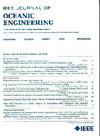Self-Supervised Marine Organism Detection From Underwater Images
IF 3.8
2区 工程技术
Q1 ENGINEERING, CIVIL
引用次数: 0
Abstract
In recent years, in light of the significant progress in deep learning on general object detection, research on marine organism detection has become increasingly popular. However, manual annotation of marine organism images usually requires specialized expertise, resulting in a scarcity of labeled data for research purposes. In addition, the complex and dynamic marine environment leads to varying degrees of light absorption and scattering, causing severe degradation issues in the collected images. These factors hinder the acquisition of high-quality representations for subsequent detection objectives. To overcome the reliance on annotated marine data sets and derive high-quality representations from extensive unlabeled and degraded data, we propose a self-supervised marine organism detection (SMOD) framework. To the best of the authors' knowledge, it is the first time that self-supervised learning has been introduced into the task of marine organism object detection. Specifically, in order to improve the quality of learned image representation from degraded data, a set of underwater augmentation strategies to improve the perceptional quality of underwater images is designed. To further address the challenging issue posed by numerous marine objects and diverse backgrounds, an underwater attention module is elaborately devised such that the model prioritizes objects over backgrounds during representation learning. Experimental results on URPC2021 data set show that our SMOD achieves competitive performance in the marine organism object detection task.基于水下图像的自监督海洋生物检测
近年来,随着深度学习在一般目标检测方面的重大进展,海洋生物检测的研究日益受到关注。然而,手工标注海洋生物图像通常需要专门的专业知识,导致用于研究目的的标记数据稀缺。此外,复杂动态的海洋环境导致不同程度的光吸收和散射,导致采集到的图像存在严重的退化问题。这些因素阻碍了后续检测目标的高质量表征的获取。为了克服对标注海洋数据集的依赖,并从大量未标记和退化的数据中获得高质量的表示,我们提出了一个自监督海洋生物检测(SMOD)框架。据作者所知,这是首次将自监督学习引入到海洋生物目标检测任务中。具体来说,为了提高从退化数据中学习到的图像表示的质量,设计了一套水下增强策略来提高水下图像的感知质量。为了进一步解决众多海洋物体和不同背景所带来的挑战性问题,我们精心设计了一个水下注意力模块,使模型在表征学习过程中优先考虑物体而不是背景。在URPC2021数据集上的实验结果表明,我们的SMOD在海洋生物目标检测任务中取得了具有竞争力的性能。
本文章由计算机程序翻译,如有差异,请以英文原文为准。
求助全文
约1分钟内获得全文
求助全文
来源期刊

IEEE Journal of Oceanic Engineering
工程技术-工程:大洋
CiteScore
9.60
自引率
12.20%
发文量
86
审稿时长
12 months
期刊介绍:
The IEEE Journal of Oceanic Engineering (ISSN 0364-9059) is the online-only quarterly publication of the IEEE Oceanic Engineering Society (IEEE OES). The scope of the Journal is the field of interest of the IEEE OES, which encompasses all aspects of science, engineering, and technology that address research, development, and operations pertaining to all bodies of water. This includes the creation of new capabilities and technologies from concept design through prototypes, testing, and operational systems to sense, explore, understand, develop, use, and responsibly manage natural resources.
 求助内容:
求助内容: 应助结果提醒方式:
应助结果提醒方式:


